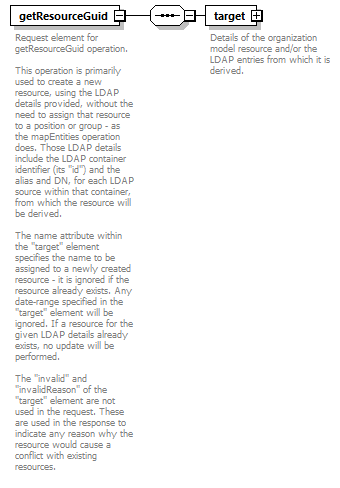| diagram |  |
||
| namespace | http://mapping.api.de.n2.tibco.com | ||
| properties |
|
||
| children | target | ||
| annotation |
|
||
| source | <xs:element name="getResourceGuid"> <xs:annotation> <xs:documentation>Request element for getResourceGuid operation. This operation is primarily used to create a new resource, using the LDAP details provided, without the need to assign that resource to a position or group - as the mapEntities operation does. Those LDAP details include the LDAP container identifier (its "id") and the alias and DN, for each LDAP source within that container, from which the resource will be derived. The name attribute within the "target" element specifies the name to be assigned to a newly created resource - it is ignored if the resource already exists. Any date-range specified in the "target" element will be ignored. If a resource for the given LDAP details already exists, no update will be performed. The "invalid" and "invalidReason" of the "target" element are not used in the request. These are used in the response to indicate any reason why the resource would cause a conflict with existing resources. </xs:documentation> </xs:annotation> <xs:complexType> <xs:sequence> <xs:element name="target" type="de:XmlLdapEntity"> <xs:annotation> <xs:documentation>Details of the organization model resource and/or the LDAP entries from which it is derived.</xs:documentation> </xs:annotation> </xs:element> </xs:sequence> </xs:complexType> </xs:element> |
element getResourceGuid/target
| diagram |  |
||||||||||||||||||||||||||||||||||||||||||||||||||||||||||||||
| type | XmlLdapEntity | ||||||||||||||||||||||||||||||||||||||||||||||||||||||||||||||
| properties |
|
||||||||||||||||||||||||||||||||||||||||||||||||||||||||||||||
| children | LdapReference | ||||||||||||||||||||||||||||||||||||||||||||||||||||||||||||||
| attributes |
|
||||||||||||||||||||||||||||||||||||||||||||||||||||||||||||||
| annotation |
|
||||||||||||||||||||||||||||||||||||||||||||||||||||||||||||||
| source | <xs:element name="target" type="de:XmlLdapEntity"> <xs:annotation> <xs:documentation>Details of the organization model resource and/or the LDAP entries from which it is derived.</xs:documentation> </xs:annotation> </xs:element> |
WSDL documentation generated by XMLSpy WSDL Editor http://www.altova.com/xmlspy